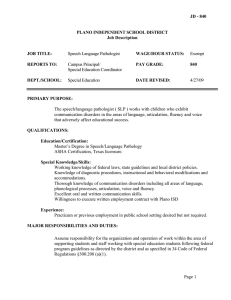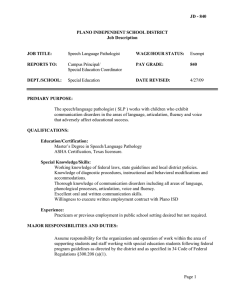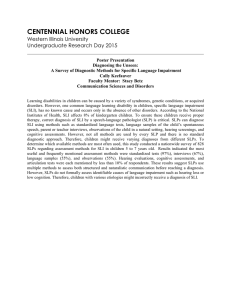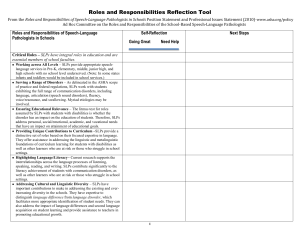The Role of the SLP in Schools A Presentation for Teachers, Community
advertisement
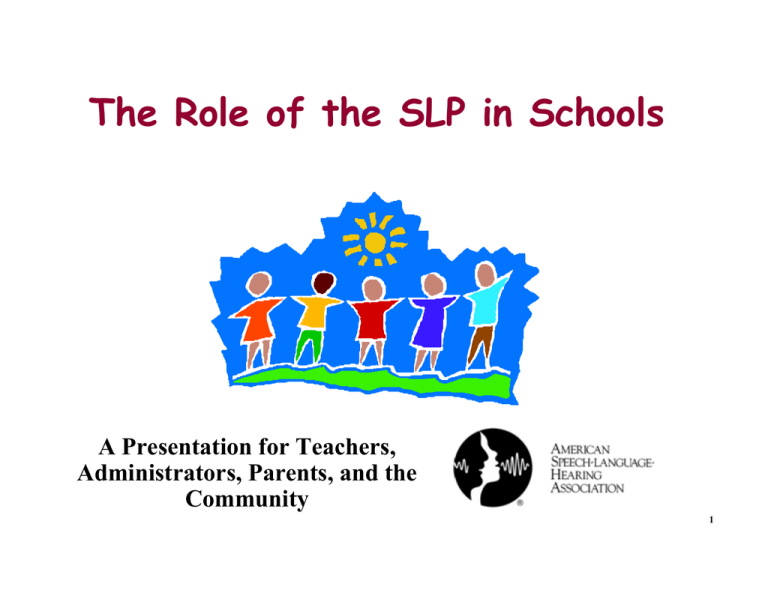
The Role of the SLP in Schools A Presentation for Teachers, Administrators, Parents, and the Community 1 Speech-Language Pathologists (SLPs) Are Specially Trained Professionals Who Have Earned: • A master’s or doctoral degree • The Certificate of Clinical Competence from the American SpeechLanguage-Hearing Association • A state license and/or Department of Education certification, where required 2 ASHA Requirements • Master’s degree • Supervised post graduate fellowship • National competitive examination 3 SLPs Work With School Children Who Have Communication Problems That Affect Success In: • • • • Classroom activities Social interaction Literacy Learning 4 The Individuals With Disabilities Education Act (IDEA) Provides Speech-Language Services For: • School-age children with communication disorders that adversely affect children’s educational performance 5 Good Communication Skills Lead to Successful: • • • • • Speaking Thinking Reading Writing Learning 6 Poor Communication Skills Lead to Problems: • Understanding classroom instruction • Participating in classroom instruction • Developing and maintaining relationships Are we still friends? 7 SLPs Work With Children Who Have A Variety Of Disabilities • • • • • Language Voice Fluency or stuttering Articulation Swallowing , also called dysphagia 8 Language Disabilities Include: • Slow development of vocabulary, concepts or grammar • Inability to use different communication styles for different situations • Poor building blocks of understanding/expressing ideas, social development, learning, reading, and writing 9 Voice Disorders • Speech that is too high, low, or monotonous in pitch • Interrupted by breaks • Too loud or too soft • Harsh, hoarse, breathy, or nasal 10 Fluency or Stuttering Problems • Interruptions in flow or rhythm • Can include hesitations, repetitions, or prolongations • Can affect sounds, syllables, words, or phrases 11 Articulation Disorders • Saying one sound for another (wabbit for rabbit) • Omitting a sound in a word (i-cream for ice cream) • Distorting a sound (thee for see) 12 Swallowing/Dysphagia • Difficulty in sucking, chewing, triggering a swallow, moving food into the stomach 13 Swallowing/Dysphagia (continued) • Interfere with eating lunch and snacks • Reduce opportunities that build friendships • Can affect social and communication skills • Can impact learning 14 Speech and Language Disorders Can Be Associated With: • Hearing loss • Cleft palate • Cerebral palsy and other motor problems • Learning disabilities 15 Speech and Language Disorders Can Be Associated With: (continued) • Autism • Developmental delays • Traumatic brain injuries • Other problems 16 SLPs Have Many Roles in Schools • Prevention of communication disorders • Identification of students at risk for later problems • Assessment of students’ communication skills • Evaluation of the results of comprehensive assessments • Development and implementation of IEPs 17 SLPs Have Many Roles in Schools (continued) • Documentation of outcomes • Collaboration with teachers and other professionals • Advocacy for teaching practices • Participation in research projects 18 SLPs Have Many Roles in Schools (continued) • Supervision of assistants • Supervision of graduate students and clinical fellows • Participation in schoolwide curriculum and literacy teams 19 SLPs Work With Children in a Variety of Ways • Combine communication goals with academic and social goals – Integrate classroom objectives – Help students understand and use basic language concepts – Support reading and writing – Increase students’ understanding of texts and lessons 20 SLPs Work With Children in a Variety of Ways (continued) • Services can vary depending on students’ needs – Monitoring or periodic screening – Collaborating and consulting – Classroom based services – Small group or individual sessions – Speech classrooms 21 Signs of Communication Disorders • Late talker • Below expectations in classroom • Difficulty learning to read and write • Unable to express thoughts and ideas 22 Signs of Communication Disorders (continued) • Problems understanding others and following directions • Doesn’t get along with others • Problems taking tests 23 How to Get Help • Meet with classroom teacher • Request a screening 24 ASHA Resources for Consumers About Communication Disorders • WWW.ASHA.ORG/public/ ASHA’s Public Web site • To Locate a Professional: WWW.ASHA.ORG/PROSERV/ • ASHA’s Action Center for Consumers: toll free 1-800-638-8255 25 Some Brochures: Your First Copy is Free • Getting Ready for Reading and Writing • IDEA and Speech-Language Services in the Schools: A Guide for Parents and Guardians • Literacy and Communication: Expectations From Kindergarten Through Fifth Grade • The Speech-Language Pathologist in Your Child’s School: An Important Resource 26 More Brochures • Child Language • Speech Sound Disorders • Stuttering • Voice Disorders Child Language 27 Still More Brochures • Ear Infections and Language Development • Hearing, Noise, and School-Aged Children • How Does Your Child Hear and Talk? ( in English, Spanish, and Chinese) 28 Questions? Press the "Esc" key on the computer's keyboard to end this presentation. 29

